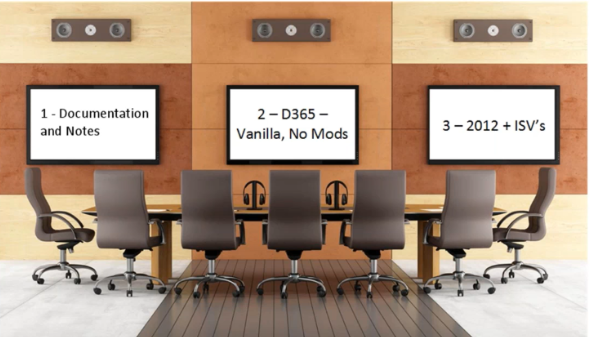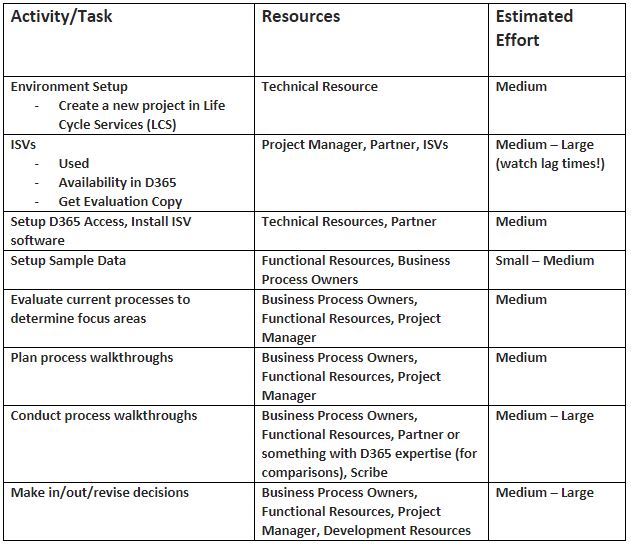Consider Code, Customizations, and Processes When Upgrading from Dynamics AX to Dynamics 365 Finance and Supply Chain Management
When you’re planning your upgrade from Dynamics AX to Dynamics 365 Finance and Supply Change Management, there is a lot to consider – including your code, customizations, processes, and ISV solutions. This blog will provide a guide to the steps you should take in order to successfully transition to Dynamics 365 and take advantage of the many benefits of a modern, cloud-based solution.
3 Major Areas to Review When Planning Your Upgrade to Dynamics 365 Finance and Supply Chain Management
- Your business processes
- The state of the code
- Your data
Continue reading to learn the steps you should take to evaluate each of these three areas.
Business Process Analysis
To set up for this phase:
- Set up a Dynamics 365 Finance and Supply Chain Management Environment
- It’s important to get a look at the system, not just for the look and feel but also so you can understand the functionality that is available.
- Get/Install ISV Solutions
- Typically, you can get an evaluation copy of these solutions from your partner or directly from the ISV.
- Setup relevant sample data
Success criteria will help determine the scope in this area:
- Identify all current business processes and evaluate what could be significantly improved
- By changing the process
- By changing the software
- What business needs have not been met
- Compare your current AX system to the base Dynamics 365 system with ISVs to assess how it will work.
Pro Tips for this Area:
- It helps to compare these on three large conference room size monitors
- Screen one – notes, documentation of changes, and system set up for Dynamics AX
- Screen two – Dynamics 365 system with ISVs
- Screen three – Dynamics AX 2012 with your modifications and ISVs
- As much as possible, try to have a bias towards the Dynamics 365 system and how processes might change to work without modification to the system. Be careful of corner cases that only rarely happen
- The more ‘vanilla’ the system is, the easier it will be to test when Microsoft provides an update. Try to minimize changes.
Steps and Set up for Project Process Analysis
Review the chart above for a list of activities that must happen in order to prepare for your upgrade, the resources you will need for each task, and an estimated level of effort to complete each one. Getting this prep done is going to be very important in your process and change evaluation. The walkthroughs will likely be the most time-consuming part of this analysis depending on the number of changes that you’ve made within AX and your current processes. You’ll likely schedule several two to four-hour sessions over a number of days to complete this step. These meetings will lead to important decisions on what to keep, leave out, or revise within your new D365 system.
The State of Your Code
There are three different options for your current code when upgrading to D365. The process evaluation outlined above is the key to determining which option is best for your company.
- If your code within AX is working flawlessly and your processes are extremely successful, you likely will want to migrate your code to D365.
- If you have changes you’d like to make, there’s a hybrid option that allows you to bring forward some, but not all, of your code. In this scenario, you use AX as a template to determine which code to keep and which to disregard.
- The third option is to disregard code. This is the best option if your code isn’t working for you anymore, if your business has gone through significant changes, or if there is new functionality in D365 that can replace the code.
Creating a feature list comparing AX and D365 can help in this determination.
Code Analysis
There are three separate ways to analyze the code within your AX environment.
1. Microsoft’s tool in Lifecycle Services (LCS)
Within LCS, there is a tool that takes your code within AX and provides a spreadsheet with data on:
- List of customizations
- What needs to be upgraded
- Areas they in
- How to break down tasks
This option gives you an idea of the level of effort required to move your customizations.
2. Stoneridge Software's Tool
Stoneridge Software does have a tool that goes through and looks through all customizations and provides analytics and more in-depth data.
- Number of objects
- Types of objects
- Estimations for upgrade effort
- Areas where customizations are located
This option gives more of an idea of areas to focus on and the true number of customizations and objects in the system for a better estimate. Our custom code evaluation tool is available for your use at no charge. Contact us to learn more.
3. Manual
The third option is the most manual and requires you to count the objects within your system. A developer needs to create a project based on a model and go through, counting each object by type and multiply by an estimated time.
Whichever option you choose, data from the code analysis can help you determine which code to migrate, and how long it will take to do so.
Pro Tip:
- There may be quite a few customizations in SSRS reports that you don’t realize are there. Make sure to consider your report changes.
New Development World
From a functionality standpoint, there are many great new features in D365 that users love. However, the main difference between AX and D365 is everything that happens in the background. While the coding language has remained the same, how code and customizations are done has completely changed. You’re now adding code and functionality on top of the solution and the base of the system is unchanged.
- Visual Studio is now being used and MorphX is gone. DevOps is required to work in D365.
- Models not Layers
- Most users have a layer they’re doing work in. But in D365, models are now more important than layers.
- No more over-layering
- Over layering was the ability to go in and completely change the base code. That is no longer available. D365 is an extension or event driven model.
- No matter what you do, the base code will always run.
- Event Handlers - Now, you subscribe to events and can determine when a certain event runs, your code will come into play.
- Web Dev
- You’ll need to start considering what code will look like in every web browser (Chrome, Edge, Safari, etc). In order to maintain performance, you’ll need to be strategic in how your code is written.
- Form Patterns
- Form patterns allow developers to be compatible across multiple browsers. There’s a list of form patterns that can be used, but you do need to follow the rules for each form pattern.
ISV Customizations
You can do research upfront on Microsoft AppSource to see which ISVs are listed and available for Dynamics 365. We do recommend calling your partner or your ISV directly to find out about their functionality and compatibility with D365. Functionality may be slightly different in the cloud-based version of their solution, or their solution may have changed drastically. Additionally, you may learn that the ISV code has not been upgraded so you may need to look at alternate solutions.
The following video highlights the implication of ISV customizations and how your development team will address ISVs as they are implemented into Dynamics 365.
Learn more about how to upgrade from Dynamics AX to Dynamics 365 Finance and Supply Chain Management by reaching out to the experts at Stoneridge Software.
Thank you for the contributions in this video and blog post by our D365 Finance & Supply Chain / Dynamics AX Practice Director Paul Kjer!
Under the terms of this license, you are authorized to share and redistribute the content across various mediums, subject to adherence to the specified conditions: you must provide proper attribution to Stoneridge as the original creator in a manner that does not imply their endorsement of your use, the material is to be utilized solely for non-commercial purposes, and alterations, modifications, or derivative works based on the original material are strictly prohibited.
Responsibility rests with the licensee to ensure that their use of the material does not violate any other rights.


